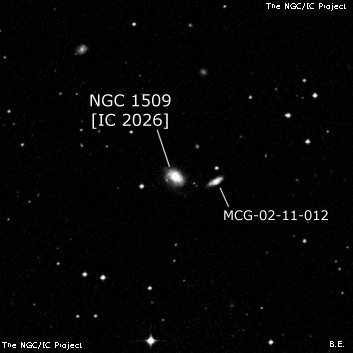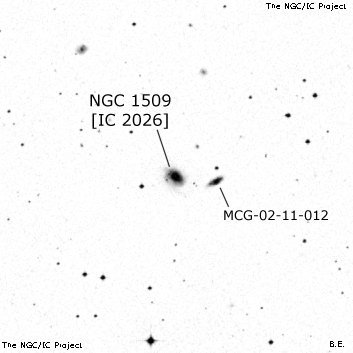NGC/IC Project Restoration Effort
(This is a very very beta version)
NGC1509


Basic Information
Location and Magnitude
Right Ascension: 4:3:55.1
Declination: -11:10:43
Constellation: ERI
Visual Magnitude: 13.7
Historic Information
Discoverer: Swift L.
Year of discovery: 1886
Discovery aperture: 16.0
Observational
Summary description: vF, vS, lE, F * nr p
Sub-type: Sa
Corwin's Notes
=====
NGC 1509 = IC 2026. NGC 1509 was found independently by Swift and by Muller
(who claimed two observations; he left us no sketch). Dreyer adopted Swift's
position (which is 12 seconds of time too large) and description, though
Muller's descriptive data certainly match what Swift recorded. (See NGC 1677
= NGC 1659 for more on other nebulae which Swift discovered on this night of
22 October 1886.)
Bigourdan tried to find the galaxy a few years later in December of 1890, but
could not see anything at the NGC position ("Searched with care, but in
vain"). His second observation seven years later was only slightly more
successful: when his measurements are reduced, they point to a star east of
the galaxy. However, he also saw the galaxy on that second night, and
measured it, too. Supposing it to be new -- it is not at the NGC position, of
course -- he listed it among his novae, so it received the IC number.
There is a fainter galaxy just to the west of NGC 1509 that is often taken as
IC 2026. I'm not surprised that Bigourdan and Swift missed it; its magnitude
is around V = 15, and it does not have a bright nucleus. However, Muller,
working with the 26-inch at Leander McCormick, has picked up fainter galaxies.
Perhaps he observed on poor nights, or perhaps he could only see high surface
brightness objects with the long-focus refractor. He makes NGC 1509 only 0.1
arcmin in diameter, which means that he saw only its core.
Finally, the 1893 list of micrometrically measured nebulae from Leander
McCormick includes a nebula claimed to be NGC 1509. Unfortunately, only the
declination was measured, so the object cannot be unambiguously identified.
However, even the measured declination does not agree with the accurate value
from Bigourdan and the modern sources. This measurement probably refers to a
star (the description given in the 1893 paper bears this out).
Steve's Notes
=====
NGC 1509
17.5" (12/30/99): faint, very small, round, 20" diameter. This is a very compact galaxy with a fairly high surface brightness. A mag 14.5 star is 1' E.
NGC 1509 = IC 2026 forms a close pair with MCG -02-11-012 = PGC 14389 just 1.2' W. At first I thought it was a very faint mag 15-15.5 star, but with extended viewing, a 15" knot was seen. This companion is often misidentified as IC 2026.



